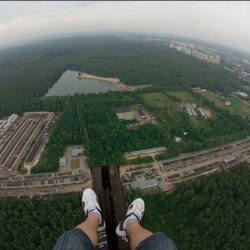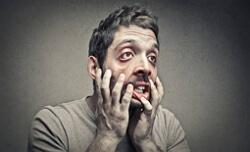Causes and treatment of acrophobia( fear of heights)
 There is a state of fear for many people. Fear of heights is called acrophobia. The nature of man was rewarded with a fear of heights, since it is really necessary. If suddenly a person is on the edge of an abyss or a high-rise building, his fear will make him retreat, saving him from obvious danger. People are treated with understanding when it comes to fear of heights. This disease is found in many people, expressed in different forms.
There is a state of fear for many people. Fear of heights is called acrophobia. The nature of man was rewarded with a fear of heights, since it is really necessary. If suddenly a person is on the edge of an abyss or a high-rise building, his fear will make him retreat, saving him from obvious danger. People are treated with understanding when it comes to fear of heights. This disease is found in many people, expressed in different forms.
However, acrophobia refers to the types of specific phobias, because a person feels inconveniences with respect to space and motion. Phobia is not only an easy fear, which is based on caution. It is a feeling of panic that takes possession of a person completely, immersing him in unlimited fear. The acrophobus can not live freely and fully, communicate with others, limiting itself constantly in those or other situations. For example, a person who has a fear of heights, is not able to go with friends to the mountains and visit ski resorts. Also acrophobes can not go to visit their friends who live above the third floor.
What is the difference between fear and phobia? Fear is a normal reaction of the body to danger. It was he who played a huge role in the evolution of man. It helps to survive, but to exist very often hinders. This happens in those cases when it grows into a neurotic one. The difference between phobia and fear is in intensity of emotion. In fact, unlike normal fear, a phobia can change the life of a person completely.
How does acrophobia manifest itself?
Not always the fear of height is the same. Acrophobes often claim that they can not control their actions at a time when they are at their best. People suffering from fear of heights are not prone to suicide attempts. There is fear in uncertainty, fears will slip and fall down from height. Bridges, overpasses and even stairs frighten acrophobic people. A person simply can refuse a trip, sit down on the ground, covering his face with his hands.
In order to understand the attack of a disease in a person, one must distinguish the symptoms of this disease. Usually acrophobia manifests as follows: the patient begins to feel dizzy, there is nausea and even vomiting. Pulse begins to slow down, the patient complains of pain in the field of raw and increased sweating. If on a walk in the mountains a person feels these symptoms - this can not be a complete proof of acrophobia. For man, a natural state - when at altitude there is a slight fear of heights.
If the fear appears every day at the slightest excuse - this is worth thinking about. A person should not be afraid in shopping centers of transparent floors and multi-storey buildings. Such manifestations can influence the psyche negatively, turning over his life. Preferences, tastes and freedom are limited. Danger of dizziness and nausea are especially dangerous, because such a condition can lead to loss of consciousness and injury during fall. It is better, if there is an accompanying person nearby who has an idea of the disease and can help. It should be borne in mind that even a healthy person in a high-altitude region can feel weakness and malaise. Such symptoms can by no means be considered signs of acrophobia.
If a person suffering from a phobia is alone with his fear rarely, you do not have to worry about it. However, a constant nervous tension when at a height is capable of damaging effects on the psyche and rhythm of life.
Causes of
Any phobia according to the statement of psychologists is caused by negative events from the past. But thanks to the latest research it was proved that this is not quite so. A number of tested people had absolutely no trouble with height in the past. It is very common in modern psychology not an associative theory, according to which the phobia of height is a prehistoric adapted phenomenon. After all, in ancient times, the danger of falling from a height was very high.
Psychologists are currently investigating whether this disease is manifested in other mammals or whether it affects only humans. It is proved that even to babies and cats it is terrible to walk on a transparent floor, under which there are free meters. However, there was no panic fear, so a phobia can not be called such a state.
How can this state be provoked? The phobia in most cases is a congenital condition. Individual individuals can progress. Repulsive moment can serve as a systematic and excessive immobilization of the newborn, falling from a height at any age, brain damage, pathology of the spine and middle ear disease. This can be all causes of disturbance of the equilibrium system. During proper operation, the brain analyzes the visual signal in the cerebral cortex. Then the proprioceptive state affects the reflexes of the vestibular apparatus. Thus, the brain determines the visual position of the body and its movements, preventing negative consequences. As a result, a person completely controls his actions. During the altitude sickness in humans, the algorithm for processing nerve signals is disrupted. Visual accents prevail, and during the passage through the brain they do not transform, so the vestibular apparatus can not decipher them.
How to defeat acrophobia
If the disease is not severe, then the patient can train and cope with his own fear. The height bar gradually rises until the habituation is established and the person learns to dominate his emotions. But if the condition is severe, a qualified specialist is needed to treat the phobia.
For the treatment of phobia, there are now many methods. There are also techniques that do not include drug therapy. The doctor with the patient conducts a conversation and identifies the possible causes of the disease and its symptoms. Then the doctor helps the patient to consider his phobia, making it less strong. This problem is successfully saved by systematic meetings with the psychoanalyst.
In acrophobia, any measures are effective. Cognitive-behavioral therapy is often used, which gives an excellent result. Thanks to such treatment, the patient's thinking and behavior are affected. In the process of therapy, muscles relax, anxiety is removed.
During the psychological treatment prescribe drugs that have a supportive effect on the patient and his psyche, until his condition becomes stable. If the treatment is for a child, then the medication is not used in therapy. The phobia of fear of height is perfectly treatable, but the patient must take an active part in it. Disease can be overcome by effort of will, controlling their fears and emotions. An effective method is considered to be the behavioral effect of personality correction. The physician helps to relax the muscles, controlling their work. Then unfocus the patient's attention. Passes training to techniques that distract from the object of fear. At the end of the therapy, work is under way to overcome the fear of height in real space.
Sometimes the phobia of height fear is treated with beta blockers. They reduce the symptoms of panic, blocking the surge of adrenaline in the patient's body. Disorders are treated with benzodiazepines. The class of benzodiazepine medications causes relaxation, but it is used much less often, because of the risk of overdose and addiction.



